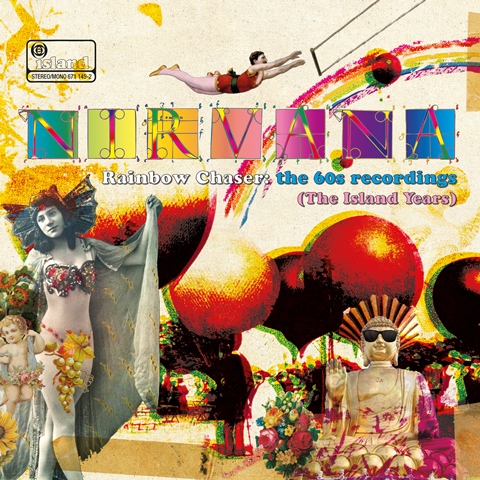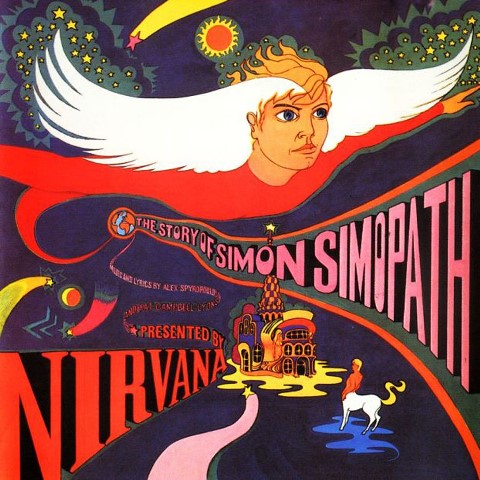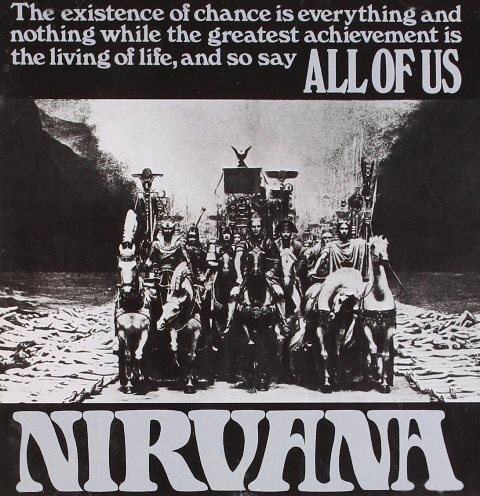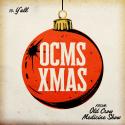In William S, Burroughs’ The Naked Lunch, a simopath was “a citizen convinced he is an ape or other simian. It is a disorder peculiar to the army and discharge cures it.” Being in uniform, then, reversed evolution.
In October 1967, a British band called Nirvana released their debut album. With its Burroughs-referencing title, The Story of Simon Simopath was a 10-track concept album telling the story of a boy longing for the wings of butterfly. Getting his wish, he flies away from reality, suffers a nervous breakdown and then boards a rocket, meets a centaur and a goddess named Magdelana who works in a hotel. The name Simon Simopath crops up in the album’s third song “We Can Help You”, a commentary on the drudgery of office work. There were no explicit references to Burroughs, but the word simopath obviously drew from his work.
 The album’s songs actually pre-existed the narrative. Nirvana’s prime movers Patrick Campbell-Lyons and Alex Spyropoulos hung the story around what they had, as The Beatles did loosely with the then-recent Sgt Pepper’s Lonely Hearts Club Band. Very much a psychedelic-pop product of 1967, The Story of Simon Simopath was one of the best British albums of the year.
The album’s songs actually pre-existed the narrative. Nirvana’s prime movers Patrick Campbell-Lyons and Alex Spyropoulos hung the story around what they had, as The Beatles did loosely with the then-recent Sgt Pepper’s Lonely Hearts Club Band. Very much a psychedelic-pop product of 1967, The Story of Simon Simopath was one of the best British albums of the year.
Musically, The Beach Boys’ Pet Sounds, the baroque side of The Beatles and The Zombies fed into The Story of Simon Simopath. Nirvana were also on a similar wavelength to producer/songwriter Mark Wirtz, who was trying to get his Teenage Opera off the ground at the same time. Hints of The Bee Gees were in there too. Sales-wise, Nirvana's high watermark was their single “Rainbow Chaser”, a minor hit in 1968.
The new double CD Rainbow Chaser: The 1960s recordings (The Island Years) collects Nirvana’s first album, their second (All Of Us, issued in August 1968), A-sides and B-sides from non-album singles, soundtrack recordings and unreleased tracks (mostly alternate versions and instrumental backing tracks). It is the last word on Nirvana's 1967–1969 tenure with Island Records.
 At this point, Island was expanding its roster beyond Jamaican artists, R&B and soul to explore progressive pop through recent signings Art (soon reconfigured as Spooky Tooth), The Smoke, Traffic and Nirvana too. Unlike the other outfits, Nirvana was not a band as such but a studio-born creation conceived by Campbell-Lyons (who is Irish) and Spyropoulos (Greek). Session players and singers were brought on board as necessary. As were Spooky Tooth, credited here as the band on two previously unheard early takes of the 1969 single “Oh! What a Performance”.
At this point, Island was expanding its roster beyond Jamaican artists, R&B and soul to explore progressive pop through recent signings Art (soon reconfigured as Spooky Tooth), The Smoke, Traffic and Nirvana too. Unlike the other outfits, Nirvana was not a band as such but a studio-born creation conceived by Campbell-Lyons (who is Irish) and Spyropoulos (Greek). Session players and singers were brought on board as necessary. As were Spooky Tooth, credited here as the band on two previously unheard early takes of the 1969 single “Oh! What a Performance”.
The Story of Simon Simopath (pictured above left) and All Of Us ((pictured below right: its full title is The Existence of Chance is Everything and Nothing While the Greatest Achievement is the Living of Life and So Say All of Us) are of a piece with each other. Both wonderful albums have been reissued previously, so much of the interest in Rainbow Chaser stems from what has not been heard before. The two original albums make up 22 of the 52 tracks.
An intriguing inclusion is “City Of The South" which was meant to be credited to “The Nirvana Orchestra” and issued as the B-side to a 1968 Island single by session singers and some-time Nirvana contributors Sue & Sunny. It was cancelled before release and its catalogue number assigned to Jethro Tull’s “A Song For Jeffrey” single. "Set Me Free", the Sue & Sunny A-side, which presumably also had a Campbell-Lyons and Spyropoulos involvement is not heard on Rainbow Chaser.
 Beyond this, two sets of previously unheard recordings stand out. The first draws from the soundtrack for the mod-ish film The Touchables, directed by Beatles’ photographer Robert Freeman. For the spin-off album, Nirvana contributed “The Touchables Theme (All Of Us)” which was subsequently reworked to became the title track of All Of Us. Heard here is a previously unreleased alternate version with vocals by the actresses from the film. Although a finished recording, it lacks the grandeur of either of the two released versions.
Beyond this, two sets of previously unheard recordings stand out. The first draws from the soundtrack for the mod-ish film The Touchables, directed by Beatles’ photographer Robert Freeman. For the spin-off album, Nirvana contributed “The Touchables Theme (All Of Us)” which was subsequently reworked to became the title track of All Of Us. Heard here is a previously unreleased alternate version with vocals by the actresses from the film. Although a finished recording, it lacks the grandeur of either of the two released versions.
Even more interesting are “Black Flower”, “Excerpt From ‘The Blind & The Beautiful’” and “Love Suite” which were recorded in March, April and May 1969 in preparation for a third Island album. When their label pulled the plug following the flop of the May 1969 single “Oh! What A Performance”, Campbell-Lyons and Spyropoulos moved to Pye International for whom the three tracks were re-recorded to form part of the Dedicated To Markos III album. This is the first chance to hear what could have been another album for Island.
Rainbow Chaser: The 1960s recordings (The Island Years) is a diligent, fascinating release which plugs gaps in the Nirvana story. In contrast, its liner notes tell the band’s story without considering the collection’s contents. How they began recording an aborted third album for Island and then left the label is not explained. It would also have been good to know about the Sue & Sunny single and how Campbell-Lyons and Spyropoulos were teamed up with Spooky Tooth but, alas, neither are addressed. Nonetheless, this fine package is an essential document of British pop at its most boundary pushing in the period before the progressive-rock era.
- Next week: Metamatic, John Foxx's debut solo album
- Read more reissue reviews on theartsdesk















Add comment